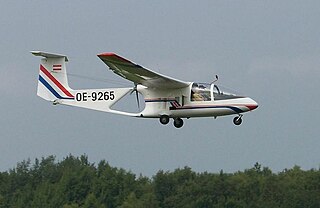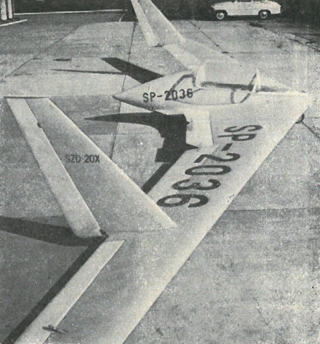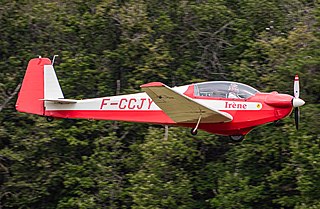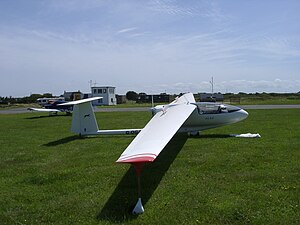
The ASW 24 is a modern single-seat high-performance composite Standard Class sailplane. It is manufactured in Germany by Alexander Schleicher GmbH & Co.

The Glaser-Dirks DG-400 is a single-seat self-launching motorglider that was produced by Glaser-Dirks between 1981 and 1992. It was the first self-launching motorglider with retractable engine and propeller to be produced in large numbers.

The M&D Flugzeugbau AVo 68 Samburo is a two-seat motor glider, first designed and manufactured in Austria.

The Brditschka HB-3, HB-21 and HB-23 are a family of motor gliders of unorthodox configuration developed in Austria in the early 1970s.
The Fauvel AV.45 was an unorthodox motor glider produced in France in the 1960s and 1970s. Like other Charles Fauvel designs, it was a tailless aircraft, in this case inspired by the work that German firms had done on producing motorised versions of his AV.36 design. The prototype of the AV.45 was an extensively modified AV.36 powered by a Nelson H-59 two-stroke engine. AV.45s have been built with a number of other engines, however, including at least one aircraft powered by a small turbojet. Falconar marketed the plans in the 1970s.

The Fauvel AV.22 was an unorthodox glider produced in France in the 1950s, 60s, and 70s. Originally intended to be produced in series, it was later marketed to homebuilders. Like other Charles Fauvel designs, it was a tailless aircraft, and this particular design featured wings with a slight forward sweep.

The Fournier RF 5 is a two-seat motor glider designed by René Fournier.

The Stemme S10 is a self-launching sailplane produced by Stemme AG in Strausberg (Germany) since the 1980s. The engine is mounted amidships and it features an unusual folding propeller which is stowed inside the aircraft's nose-cone when the engine is not in use.

The Valentin Taifun is a two-seat self-launching sailplane designed and built by Valentin Flugzeugbau GmbH of Hasfurt, Germany.

The Scheibe SF-25 Falke is a German touring motor glider developed from the earlier Bergfalke glider by Scheibe Flugzeugbau. Since May 2006 the business has been run by Scheibe Aircraft GmbH.

The SZD-20x Wampir II was a single-seat tail-less research glider designed and built in Poland from 1959.

The Scheibe SF 28 Tandem-Falke is a German motorglider that was designed by Egon Scheibe in 1970 and which flew for the first time in May the following year. It was a development of the Scheibe Falke with seating in tandem rather than side-by-side as in the original Falke design.
The TeST TST-13 Junior is a single-seat touring motor glider with a nose-mounted engine, built by TeST in Czech Republic. It is an all composite design which succeeded the TeST TST-9 Junior motor glider in production, incorporating some features of the TeST TST-10 Atlas sailplane, including its wing.

The Akaflieg Berlin B13 is a two-seat motor-glider designed and built in Germany.
The Strojnik S-2 is an American high-wing, single-seat motor glider that was designed and built by Aleš Strojnik.

The Radab Windex is a family of Swedish high-wing, single-seat aerobatic gliders and motor gliders that was designed by Sven Olof Ridder and produced initially by Radab and later by WindexAir AB as a kit for amateur construction.
The Akaflieg Darmstadt D-39 was a single-seat motor glider derived from the D-38 sailplane. Built in Germany in the late 1970s, it was not intended for production and only one was constructed.
The Kortenbach & Rauh Kora 1 was an unusual twin boom, pusher configuration motor glider, designed and built in Germany in the 1970s and intended as a training aircraft.
The IIL IS-9 was a low powered, experimental pod and boom style motor glider, designed and built in Romania in the late 1950s.

The Politechnika Warszawska PW-4 Pelikan was a motor-glider variant of the two seat Polish PW-3 Bakcyl glider. Only one flew.

















